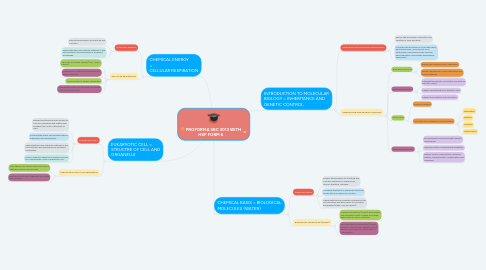
1. CHEMICAL ENERGY = CELLULAR RESPIRATION
1.1. CHEMICAL ENERGY
1.1.1. Explain the principles of structure and function .
1.1.2. Appreciate the role scientific methods in the accumulation and discoveries of biological knowledge.
1.2. CELLULAR RESPIRATION
1.2.1. Structure of energy carriers (ATP, NADH, FADH2)
1.2.2. Importance of energy and respiration in living organisms.
1.2.3. Various stage of aerobic respiration
1.2.4. Describe glycolysis and calculate net energy produced in glycolysis.
2. EUKARYOTIC CELL = STRUCTRE OF CELL AND ORGANELLE
2.1. EUKARYOTIC CELL
2.1.1. Explain the structure and function of cells and recognize the relationship between two major categories of cells.
2.1.2. Compare the major cellular processes in eukaryotes and prokaryotes.
2.1.3. Appreciate the role scientific methods in the accumulation and discoveries of biological knowledge.
2.1.4. Work in teams to apply the scientific process for a panaromatic view of eukaryotic cell.
2.2. STRUCTRE OF CELL AND ORGANELLE
2.2.1. state theory and explain basis principle of light and electron microscopy
2.2.2. describe structure of organelles and state their function
3. INTRODUCTION TO MOLECULAR BIOLOGY = INHERITANCE AND GENETIC CONTROL
3.1. INTRODUCTION TO MOLECULAR BIOLOGY
3.1.1. Explain the principles of structure and function of DNA and RNA.
3.1.2. Compare the processes in DNA replication, gene expression, recombinant DNA technology, polymerase chain reaction, gene regulation and genetic engineering application.
3.2. INHERITANCE AND GENETIC CONTROL
3.2.1. DNA REPLICATION
3.2.1.1. Explain the models of DNA replication
3.2.1.2. Explain mechanism of DNA replication and role of enzymes
3.2.2. GENE EXPRESSION
3.2.2.1. Interpret the genetic code table and identify the anti-codon.
3.2.2.2. Explain characteristics of genetic code.
3.2.2.3. Explain transcription and translation.
3.2.3. MUTATION
3.2.3.1. Type of mutation
3.2.3.2. Four structural changes in chromosomes:
3.2.3.2.1. Duplication
3.2.3.2.2. Deletion
3.2.3.2.3. Inversion
3.2.3.2.4. Translocation
3.2.4. GENE TECHNOLOGY
3.2.4.1. Recombinant DNA technology/ genetic engineering
3.2.4.2. Describe vector in cloning and properties.
3.2.4.3. Explain reverse, transcription, insertion, ligation, transformation, amplification and screening.
4. CHEMICAL BASIS = BIOLOGICAL MOLECULES (WATER)
4.1. CHEMICAL BASIS
4.1.1. Explain the principles of structure and function elements of compounds, atomic structure, isotopes.
4.1.2. Compare the types of chemicals bond and molecules and chemicals reaction.
4.1.3. Appreciate the role scientific methods in the accumulation and discoveries of biological knowledge (water, acid and bases).
4.2. BIOLOGICAL MOLECULES (WATER)
4.2.1. Chemical properties (solvent bond angles and hydrogen bond) of water and relate physiological roles in organism
4.2.2. Describe physical properties (solvent, polarity, cohesiveness, density, suface tension, heat capacity, latent heat of vaporisation.
